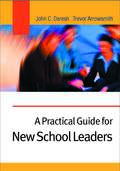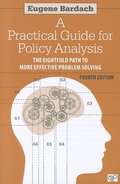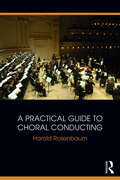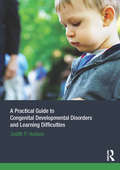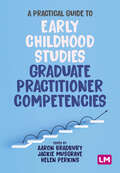- Table View
- List View
A Practical Guide for New School Leaders (PDF)
by John C. Daresh Mr Trevor Arrowsmith`An inspiring resource for Headteachers, deputy Headteachers and any primary teacher who desires a leadership rile. All teachers who want to lead, or want to make themselves aware of problems faced by leaders, will not only find this book useful and informative but will learn a lot from it too' - Junior Education `This book is full of so many practical ides that new heads will surely be enthused to try something new and put energy into their new role, especially as this is supported by an outstanding detailed analysis of the frequent problems that those new to headship will face, enhanced by interesting and well-chose case studies. I am sure that this is one of books whose reputation will grow by word of mouth by those who have used it, to their colleagues. It deserves to be, and I am sure will be come a classic' - The International Journal of Educational Management `A Practical Guide to New School Leaders will be appreciated by those taking up new posts as head or deputy and should be part of their personal collections' - Tim Brighouse, Times Educational Supplement `In summary, this book makes an excellent contribution to the current debate on Leadership from a practical point of view. It provides an important resource for many aspects of leadership development programmes at a variety of levels. As a resource for both the newly appointed headteacher and those involved in their training it contributes to ensuring that the new headteacher will become a reflective thinker in terms of his/her early career as school leader. The book offers concrete strategies, case studies and checklists to help the new school leader to develop an individual action plan in order to survive and thrive' - Stephen Merrill, Edge Hill College of Higher Education, Journal In-Service Education New head teachers need help as they walk the tightrope between surviving the first years in the job and becoming strong and effective instructional leaders. John C Daresh and Trevor Arrowsmith offer concrete strategies, case studies and a personal leadership checklist to help the new school leader develop an individual plan to thrive and survive. Key features include: Real-life concerns facing new school leaders; technical and managerial skills to survive socializing to the role of a leader; strong leadership through self-awareness; the road to school leadership - making the most of being an assistant or deputy; developing personal portfolios and action plans. The book also provides answers to questions that concern new school leaders. This is a practical and essential resource for head teachers, deputy head teachers and all those aspiring towards a leadership role in schools. John C Daresh is currently professor of educational leadership at the University of Texas at El Paso. He has served as a consultant for universities and departments of education across the USA, Europe, Asia and Africa. Trevor Arrowsmith has been Principal of a Specialist Secondary School Language College in Northampton for 8 years. He is also LPSH national trainer and an External Advisor on heads performance management.
A Practical Guide for Policy Analysis: The Eightfold Path to More Effective Problem Solving (PDF)
by Eugene S. BardachWith his original eightfold approach, Eugene Bardach encapsulates more than 35 years of teaching students effective, accurate and persuasive policy analysis. This bestselling handbook presents dozens of concrete tips, interesting case studies and step-by-step strategies for the budding analyst as well as the seasoned professional. In this new edition, Bardach clarifies some of the book′s exposition, paying particular attention to "design problems" and the choice of a "base case". Up-to-date examples, including a new set of environmental problems, make the book even more engaging. Readers will also appreciate a sample document of real world policy analysis, a primer in how to "talk the talk" of policy analysis, and a cheat sheet of strategies for solving a host of policy problems.
A Practical Guide: The National Standards of Excellence for Headteachers
by Roy BlatchfordThis Practical Guide seeks to illuminate the National Standards of Excellence for Headteachers, presenting a range of perspectives to bring the text alive for current and future school leaders and for those with the vital responsibilities of proper governance. Part Two of the book comprises the official Standards published by the DfE, by way of handy reference.
A Practical Guide to Academic Research
by Birley, Graham (Head, Education Research Unit, University of Wolverhampton) Moreland, Neil (Associate Dean, School of Education, University of Wolverhampton)Covering all aspects of research methodology, this research tool also deals with planning issues and self-management techniques needed by the researcher. It contains information on data analysis and advice for staff members needing support from their institutions to pursue research.
A Practical Guide to Academic Research
by Birley, Graham (Head, Education Research Unit, University of Wolverhampton) Moreland, Neil (Associate Dean, School of Education, University of Wolverhampton)Covering all aspects of research methodology, this research tool also deals with planning issues and self-management techniques needed by the researcher. It contains information on data analysis and advice for staff members needing support from their institutions to pursue research.
A Practical Guide to Action Research and Teacher Enquiry: Making a Difference in the Early Years
by Amanda Ince Eleanor KittoThis accessible guide will be an invaluable resource for early years practitioners looking to make a positive difference in their settings by using action research or teacher enquiry. Guiding readers through the practical steps, issues, and potentials of conducting research in a variety of early childhood settings, the book will increase practitioners’ confidence, enabling them to bridge the gap between recognising room for improvements and instigating necessary changes. Divided into easy-to-follow sections, A Practical Guide to Action Research and Teacher Enquiry: Making a Difference in the Early Years offers clear definitions and explanations of action research along with explanations of how it can be applied in early years settings to effectively and efficiently improve outcomes for children. Chapters outline a clear rationale for engaging in action research, highlight purposes and potentials of various approaches, and provide a helpful step-by-step discussion of the different stages of enquiry. Ten examples of practice are used to clearly illustrate the action research cycle in a variety of settings, and in relation to a range of topics and ages, thereby providing readers with a wealth of tried-and-tested ideas for application in their own settings and projects. These are supported by a range of downloadable resources which can be used as tools to support the planning, reflecting, and evaluation of practitioners’ research activities. Informative, inspiring, and highly relevant to practice, A Practical Guide to Action Research and Teacher Enquiry will support and scaffold the research activities of early years practitioners, managers, and students.
A Practical Guide to Action Research and Teacher Enquiry: Making a Difference in the Early Years
by Amanda Ince Eleanor KittoThis accessible guide will be an invaluable resource for early years practitioners looking to make a positive difference in their settings by using action research or teacher enquiry. Guiding readers through the practical steps, issues, and potentials of conducting research in a variety of early childhood settings, the book will increase practitioners’ confidence, enabling them to bridge the gap between recognising room for improvements and instigating necessary changes. Divided into easy-to-follow sections, A Practical Guide to Action Research and Teacher Enquiry: Making a Difference in the Early Years offers clear definitions and explanations of action research along with explanations of how it can be applied in early years settings to effectively and efficiently improve outcomes for children. Chapters outline a clear rationale for engaging in action research, highlight purposes and potentials of various approaches, and provide a helpful step-by-step discussion of the different stages of enquiry. Ten examples of practice are used to clearly illustrate the action research cycle in a variety of settings, and in relation to a range of topics and ages, thereby providing readers with a wealth of tried-and-tested ideas for application in their own settings and projects. These are supported by a range of downloadable resources which can be used as tools to support the planning, reflecting, and evaluation of practitioners’ research activities. Informative, inspiring, and highly relevant to practice, A Practical Guide to Action Research and Teacher Enquiry will support and scaffold the research activities of early years practitioners, managers, and students.
A Practical Guide to Arts-related Research
by Maggi Savin Baden Katherine WimpennyThis book outlines the principles and practices of arts-related inquiry and provides both suggestions about conducting research in the field as well as case study examples. The ideas presented here have emerged from the authors’ own experiences of undertaking arts-related research and the challenges of implementing these approaches. The book therefore draws on personal research, practice and experience to address the concerns academics increasingly appear to be voicing about developing the scholarship and practice of arts-related research. There is a need for greater attention to, and clarity on, issues of theoretical positioning, methodology and methods when conducting robust and reputable arts-related research, which this book provides.
A Practical Guide to Becoming a Community College President
by Edward J. Valeau Rosalind Latiner RabyThis practical resource helps aspiring leaders demystify the challenges associated with becoming a community college president. Building on existing scholarship and research related to historical origins of the community college, this book explores the role and function of the presidency, discusses existing demographics and the importance of meeting the needs of a diverse student population, and unpacks the required competencies and leadership challenges related to becoming a community college president. Including real voices from award-winning and current presidents as well as a step-by-step approach to attaining the position, this is an important resource that speaks to the needs of today and tomorrows’ community college leaders.
A Practical Guide to Becoming a Community College President
by Edward J. Valeau Rosalind Latiner RabyThis practical resource helps aspiring leaders demystify the challenges associated with becoming a community college president. Building on existing scholarship and research related to historical origins of the community college, this book explores the role and function of the presidency, discusses existing demographics and the importance of meeting the needs of a diverse student population, and unpacks the required competencies and leadership challenges related to becoming a community college president. Including real voices from award-winning and current presidents as well as a step-by-step approach to attaining the position, this is an important resource that speaks to the needs of today and tomorrows’ community college leaders.
A Practical Guide to Biomedical Research: for the Aspiring Scientist
by Peter Agger Robert S. Stephenson J. Michael HasenkamThis book advises and supports novice researchers in taking their first steps into the world of scientific research. Through practical tips and tricks presented in a clear, concise and step-wise manner, the book describes the entire research process from idea to publication. It also gives the reader insight into the vast opportunities a research career can provide. The books target demographic is aspiring researchers within the biomedical professions, be it medical students, young doctors, nurses, engineers, physiotherapists etc. The book will help aspirational inexperienced researchers turn their intentions into actions, providing crucial guidance for successful entry into the field of biomedical research.
A Practical Guide to Building Professional Competencies in School Psychology
by Timothy M. M. Lionetti, Edward P. P. Snyder and Ray W. W. ChristnerDesigned as a research-based yet matter-of-fact guide for beginning and future scientist-practitioners, A Practical Guide to Building Professional Competencies in School Psychology skillfully augments the reader’s training, supervision, and experience by providing a framework for honing essential skills in the field. This reader-friendly, evidence-based text encourages the continuing development of expertise in communication and collaborative skills, diversity awareness, technical knowledge, and other domains critical to building and maintaining an ethical, meaningful practice.Each chapter in this must-have volume examines a core area of expertise in depth, and provides checklists (linked to competencies set out in NASP’s Blueprint III) and the Development and Enhancement of Competencies Assessment Form are included to enable readers to gain a more complete understanding of their professional strengths and needs.The skill sets covered include:Developing cross-cultural competencies.Evaluating students with emotional and behavioral problems.Assessing student skills using a variety of approaches.Preventing and intervening in crisis situations.Consulting with families, colleagues, and the community.Facilitating mental health services in the school setting.A Practical Guide to Building Professional Competencies in School Psychology provides an invaluable set of professional development tools for new practitioners and graduate students in school psychology.
A Practical Guide to Career Learning and Development: Innovation in careers education 11-19
by Barbara Bassot Anthony Barnes Anne ChantA Practical Guide to Career Learning and Development is an essential guide for all those involved in careers education, either with sole responsibility or as part of a team. With a focus on career happiness, resilience and growth, this exciting book offers effective pedagogical strategies, techniques and activities to make career learning and development accessible and enjoyable, contributing to positive outcomes for all young people in the 11-19 phase of their education. With a wealth of support material such as teaching ideas, lesson plans, case studies and an illustrative student commentary, key topics covered include: Career Learning and Development needs of young people Career Learning and Development in the curriculum Practical activities for 11-14, 14-16 and 16-19 year olds Creating a positive environment for learning Teaching approaches Leadership and management Facilitating professional learning. A Practical Guide to Career Learning and Development is an invaluable resource for careers advisers and staff in schools with responsibility for leading and providing careers education as well as work-related learning, PSHE, citizenship, and pastoral programmes. It enables and supports all practitioners as they develop careers provision that better prepares young people for their future well-being and an ever-changing and unpredictable world of work.
A Practical Guide to Career Learning and Development: Innovation in careers education 11-19
by Barbara Bassot Anthony Barnes Anne ChantA Practical Guide to Career Learning and Development is an essential guide for all those involved in careers education, either with sole responsibility or as part of a team. With a focus on career happiness, resilience and growth, this exciting book offers effective pedagogical strategies, techniques and activities to make career learning and development accessible and enjoyable, contributing to positive outcomes for all young people in the 11-19 phase of their education. With a wealth of support material such as teaching ideas, lesson plans, case studies and an illustrative student commentary, key topics covered include: Career Learning and Development needs of young people Career Learning and Development in the curriculum Practical activities for 11-14, 14-16 and 16-19 year olds Creating a positive environment for learning Teaching approaches Leadership and management Facilitating professional learning. A Practical Guide to Career Learning and Development is an invaluable resource for careers advisers and staff in schools with responsibility for leading and providing careers education as well as work-related learning, PSHE, citizenship, and pastoral programmes. It enables and supports all practitioners as they develop careers provision that better prepares young people for their future well-being and an ever-changing and unpredictable world of work.
A Practical Guide to Child Observation and Assessment (Fourth Edition) (PDF)
by Christine Hobart Jill Frankel Miranda WalkerObservation is a fundamental part of early years daily practice which enhances students’ understanding of the development and needs of children. This best-selling book has been revised to provide a fully updated colour guide that will continue to help practitioners improve their skills in observing children and writing up these observations. A Practical Guide to Child Observation and Assessment, 4th Edition provides: # Full explanations of how and why we observe children # A wealth of observation examples, including babies and primary school-aged children # An introduction to the Early Years Foundation Stage Profile # An overview of the assessment in the Early Years Foundation Stage and National Curriculum # Clear coverage of the various observation recording methods and evaluation techniques # Specially commissioned colour photographs to illustrate the text # Activities throughout the book to encourage student learning. This book covers child observation components of all major childcare courses.
A Practical Guide to Choral Conducting
by Harold RosenbaumRooted in the experience of a professional choral conductor, this book provides a guide to practical issues facing conductors of choral ensembles at all levels, from youth choruses to university ensembles, church and community choirs, and professional vocal groups. Paired with the discussion of practical challenges is a discussion of over fifty key works from the choral literature, with performance suggestions to aid the choral conductor in directing each piece. Dealing with often-overlooked yet vital considerations such as how to work with composers, recording, concert halls, and choral tours, A Practical Guide to Choral Conducting offers a valuable resource for both emerging choral conductors and students of choral conducting at the undergraduate and graduate levels.
A Practical Guide to Choral Conducting
by Harold RosenbaumRooted in the experience of a professional choral conductor, this book provides a guide to practical issues facing conductors of choral ensembles at all levels, from youth choruses to university ensembles, church and community choirs, and professional vocal groups. Paired with the discussion of practical challenges is a discussion of over fifty key works from the choral literature, with performance suggestions to aid the choral conductor in directing each piece. Dealing with often-overlooked yet vital considerations such as how to work with composers, recording, concert halls, and choral tours, A Practical Guide to Choral Conducting offers a valuable resource for both emerging choral conductors and students of choral conducting at the undergraduate and graduate levels.
A Practical Guide to Congenital Developmental Disorders and Learning Difficulties
by Judith P. HudsonTo give children with congenital developmental conditions that manifest special learning needs and specific disabilities their best chance to succeed, early identification and appropriate interventions and support, is necessary. This text highlights what to look for when there are concerns about a child’s development. Practical and accessible, it is divided into three sections: Part 1 looks at the theory and policy context, discussing the social model of disability, the responsibility of health, social care and education services to the child and family and the role of reviews and assessment in recognising developmental disorders. Part 2 provides a reference guide to atypical developmental conditions and disorders. For each condition, aetiology, prominent theories and research, profile of features – including triggers and behaviours, diagnostic assessment procedures and appropriate interventions are given and links made to sources of further information and support. Part 3 explores practical issues how to work sensitively and effectively with children and their families, looking at the psychological implications of diagnosis, and how to plan, promote, deliver and evaluate multi-agency support. Designed to support professionals working within a multi-modal, collaborative approach to assessment and intervention processes, it is suitable for health visitors, allied health therapists, nurses, teachers and social care practitioners. It is also a useful reference for students in these areas learning about child development and includes critical reading exercises; online searching tasks; self-assessment questions; reflective activities and document analysis prompts.
A Practical Guide to Congenital Developmental Disorders and Learning Difficulties
by Judith P. HudsonTo give children with congenital developmental conditions that manifest special learning needs and specific disabilities their best chance to succeed, early identification and appropriate interventions and support, is necessary. This text highlights what to look for when there are concerns about a child’s development. Practical and accessible, it is divided into three sections: Part 1 looks at the theory and policy context, discussing the social model of disability, the responsibility of health, social care and education services to the child and family and the role of reviews and assessment in recognising developmental disorders. Part 2 provides a reference guide to atypical developmental conditions and disorders. For each condition, aetiology, prominent theories and research, profile of features – including triggers and behaviours, diagnostic assessment procedures and appropriate interventions are given and links made to sources of further information and support. Part 3 explores practical issues how to work sensitively and effectively with children and their families, looking at the psychological implications of diagnosis, and how to plan, promote, deliver and evaluate multi-agency support. Designed to support professionals working within a multi-modal, collaborative approach to assessment and intervention processes, it is suitable for health visitors, allied health therapists, nurses, teachers and social care practitioners. It is also a useful reference for students in these areas learning about child development and includes critical reading exercises; online searching tasks; self-assessment questions; reflective activities and document analysis prompts.
The Practical Guide to Corporate Social Responsibility: Do the Right Thing
by Stephen Asbury Richard BallCorporate social responsibility has gained substantial traction in recent decades but many still struggle with conveying the importance of integrating ethics and environmental and social values within the demands of a business world understandably concerned with making profit. First published in 2009 as ‘Do the Right Thing’, The Practical Guide to Corporate Social Responsibility guides you through the basics, teaching how to recognise CSR benefits and put principles into practice in a business-focussed way. This new edition helps readers get to grips with improving their organisation's environmental management, sustainability, health and safety and trading ethics with straightforward guidance and tips. A new ‘Do The Right Thing’ Model assists organisations with identifying risks and frames corporate social responsibility in a business context accessible to all. Features include: An updated Do the Right Thing Model aligned to the new ISO high level structure for management system standards 20 global case studies to demonstrate how the model can impact performance A corporate social responsibility policy template for your organisation’s use Helpful 'Test your thinking' exercises to check your understanding and stretch your working knowledge 100 practical actions for you to start implementing today This is an essential introduction to the complex areas of corporate social responsibility that affect health and safety practitioners, environmental managers, human resources personnel and those working with quality and business assurance. It will also be critical reading for those looking to understand how CSR fits into the new high level structure of ISO 9001, ISO 14001 and ISO 45001.
The Practical Guide to Corporate Social Responsibility: Do the Right Thing
by Stephen Asbury Richard BallCorporate social responsibility has gained substantial traction in recent decades but many still struggle with conveying the importance of integrating ethics and environmental and social values within the demands of a business world understandably concerned with making profit. First published in 2009 as ‘Do the Right Thing’, The Practical Guide to Corporate Social Responsibility guides you through the basics, teaching how to recognise CSR benefits and put principles into practice in a business-focussed way. This new edition helps readers get to grips with improving their organisation's environmental management, sustainability, health and safety and trading ethics with straightforward guidance and tips. A new ‘Do The Right Thing’ Model assists organisations with identifying risks and frames corporate social responsibility in a business context accessible to all. Features include: An updated Do the Right Thing Model aligned to the new ISO high level structure for management system standards 20 global case studies to demonstrate how the model can impact performance A corporate social responsibility policy template for your organisation’s use Helpful 'Test your thinking' exercises to check your understanding and stretch your working knowledge 100 practical actions for you to start implementing today This is an essential introduction to the complex areas of corporate social responsibility that affect health and safety practitioners, environmental managers, human resources personnel and those working with quality and business assurance. It will also be critical reading for those looking to understand how CSR fits into the new high level structure of ISO 9001, ISO 14001 and ISO 45001.
A Practical Guide to Creative Writing in Schools: Seven Creative Writing Projects for Ages 8-14
by Fiona ClarkThis book contains seven tried-and-tested creative writing projects for pupils aged 8–14. Each project is delivered through a series of workshops and enables pupils to explore a literary genre or writing style, discuss themes and topics and receive constructive feedback about their writing. The projects cover topics such as identity, cultural heritage, tolerance, empathy, morality, dreams and much more. Teachers wanting to run creative writing projects will find this book easy to follow, practical and timesaving. Each project allows students to: • explore a certain literary genre or writing style in detail • be creative and have fun while learning • think about, talk about and discuss themes and topics • receive constructive feedback about their writing • pursue their own ideas • see themselves as ‘real’ writers with a ‘real’ audience • understand that writing can be enjoyable, artistic and relaxing • experience creativity to improve their wellbeing. These ready-made projects are invaluable for teachers who are looking for new and successful creative writing projects for a range of students. They will enable teachers to immediately start making a difference to their students’ confidence and writing skills, allowing them to be as creative and imaginative as possible and use creativity as a springboard for their own writing.
A Practical Guide to Creative Writing in Schools: Seven Creative Writing Projects for Ages 8-14
by Fiona ClarkThis book contains seven tried-and-tested creative writing projects for pupils aged 8–14. Each project is delivered through a series of workshops and enables pupils to explore a literary genre or writing style, discuss themes and topics and receive constructive feedback about their writing. The projects cover topics such as identity, cultural heritage, tolerance, empathy, morality, dreams and much more. Teachers wanting to run creative writing projects will find this book easy to follow, practical and timesaving. Each project allows students to: • explore a certain literary genre or writing style in detail • be creative and have fun while learning • think about, talk about and discuss themes and topics • receive constructive feedback about their writing • pursue their own ideas • see themselves as ‘real’ writers with a ‘real’ audience • understand that writing can be enjoyable, artistic and relaxing • experience creativity to improve their wellbeing. These ready-made projects are invaluable for teachers who are looking for new and successful creative writing projects for a range of students. They will enable teachers to immediately start making a difference to their students’ confidence and writing skills, allowing them to be as creative and imaginative as possible and use creativity as a springboard for their own writing.
The Practical Guide to Drawing Animals (Artist's Workbooks)
by Peter GrayFascinating, endearing and endlessly varied, animals make inspirational subject matter for artists. In Drawing Animals, author and illustrator Peter Gray guides you through the stages of capturing animal shapes, behaviour and expression to create accomplished artworks. Whether you are a complete beginner or a more experienced draughtsman, the tailored step-by-step exercises and practical tips will help you get the most out of your animal subjects.This is another title in Arcturus' successful range of Artist's Workbooks, which also includes titles on: Portraits, Figures, Manga, Techniques, Landscape, Animals and Still Life.
A Practical Guide to Early Childhood Studies Graduate Practitioner Competencies
by Aaron Bradbury Jackie Musgrave Helen PerkinsWhat do the Early Childhood Studies Graduate Practitioner Competencies (GPCs) mean in practice? What do they look like in settings? This book brings you case studies as examples of good practice demonstrating all of the GPCs. Each chapter covers a specific competency and includes: A visualisation of the competency Case studies to explore what each competency looks like in practice Expert commentary on each case study helping you to link theory to practice
